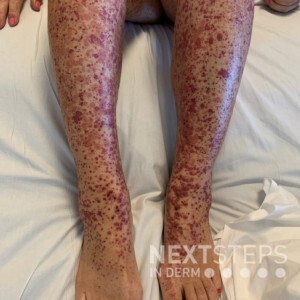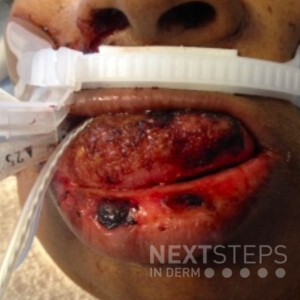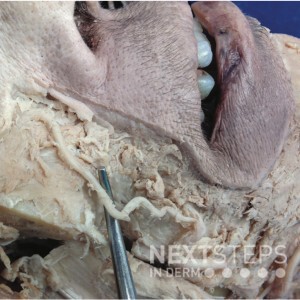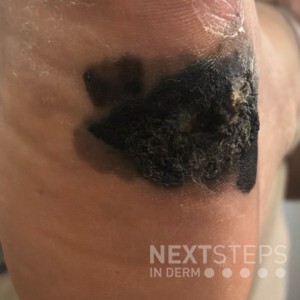Skin Rash – Friday Pop Quiz 3/26
 This 17-year-old boy also reports dark urine, bilateral knee pain, and intermittent abdominal pain. Which of the following is true regarding this condition?
A. It is more common in adults than children
B. A DIF biopsy showing intravascular IgA deposition is diagnostic
C. It usually occurs after a respiratory tract infection
D. He has a high likelihood of developing permanent renal …
This 17-year-old boy also reports dark urine, bilateral knee pain, and intermittent abdominal pain. Which of the following is true regarding this condition?
A. It is more common in adults than children
B. A DIF biopsy showing intravascular IgA deposition is diagnostic
C. It usually occurs after a respiratory tract infection
D. He has a high likelihood of developing permanent renal …
 This 17-year-old boy also reports dark urine, bilateral knee pain, and intermittent abdominal pain. Which of the following is true regarding this condition?
A. It is more common in adults than children
B. A DIF biopsy showing intravascular IgA deposition is diagnostic
C. It usually occurs after a respiratory tract infection
D. He has a high likelihood of developing permanent renal …
This 17-year-old boy also reports dark urine, bilateral knee pain, and intermittent abdominal pain. Which of the following is true regarding this condition?
A. It is more common in adults than children
B. A DIF biopsy showing intravascular IgA deposition is diagnostic
C. It usually occurs after a respiratory tract infection
D. He has a high likelihood of developing permanent renal … 

 A 42-year-old patient develops an abrupt and short-lived swelling of her tongue, mouth, and mucous membranes. There are no other parts of the body affected. The swelling is most pronounced around the eyes and lips. The internal lining of the upper respiratory tract is involved and the patient is immediately intubated. You suspect a diagnosis of angioedema. Which of the following medications th …
A 42-year-old patient develops an abrupt and short-lived swelling of her tongue, mouth, and mucous membranes. There are no other parts of the body affected. The swelling is most pronounced around the eyes and lips. The internal lining of the upper respiratory tract is involved and the patient is immediately intubated. You suspect a diagnosis of angioedema. Which of the following medications th …  What structure is being lifted by the dissecting probe?
A. Angular artery
B. Transverse facial artery
C. Buccal nerve
D. Mental nerve
E. Superior labial artery
To find out the correct answer and read the explanation, click here.
Brought to you by our brand partner Derm In-Review. A product of SanovaWorks.
…
What structure is being lifted by the dissecting probe?
A. Angular artery
B. Transverse facial artery
C. Buccal nerve
D. Mental nerve
E. Superior labial artery
To find out the correct answer and read the explanation, click here.
Brought to you by our brand partner Derm In-Review. A product of SanovaWorks.
…  This 32-year-old man has two sisters each with melanoma, and his father died from metastatic pancreatic cancer. You suspect a germline mutation in which of the following genes?
A. BAP1
B. TERT
C. MITF
D. CDKN2A
E. PTCH
To find out the correct answer and read the explanation, click here.
Brought to you by our brand partner Derm In-Review. A product of SanovaWorks.
…
This 32-year-old man has two sisters each with melanoma, and his father died from metastatic pancreatic cancer. You suspect a germline mutation in which of the following genes?
A. BAP1
B. TERT
C. MITF
D. CDKN2A
E. PTCH
To find out the correct answer and read the explanation, click here.
Brought to you by our brand partner Derm In-Review. A product of SanovaWorks.
…  Histologically, this lesion shows plump, polygonal cells arranged in nests and fascicles with granular cytoplasm. Which immunohistochemical stain would be positive?
A. CD31
B. Synaptophysin
C. Factor XIIIa
D. S-100
E. CD34
To find out the correct answer and read the explanation, click here.
Brought to you by our brand partner Derm In-Review. A product of SanovaWorks.
…
Histologically, this lesion shows plump, polygonal cells arranged in nests and fascicles with granular cytoplasm. Which immunohistochemical stain would be positive?
A. CD31
B. Synaptophysin
C. Factor XIIIa
D. S-100
E. CD34
To find out the correct answer and read the explanation, click here.
Brought to you by our brand partner Derm In-Review. A product of SanovaWorks.
…